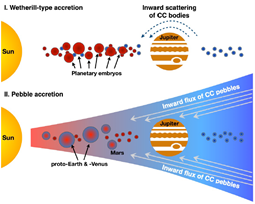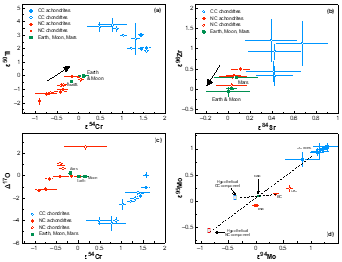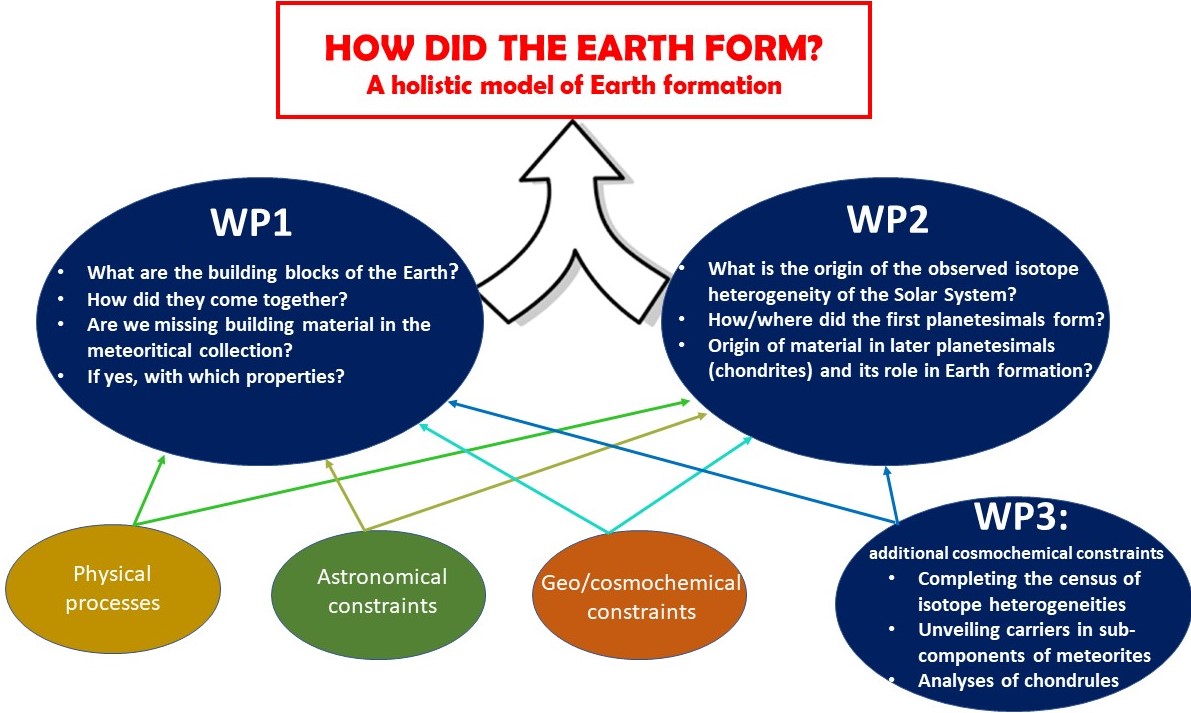
 HolyEarth
HolyEarth
A holistic approach to understand Earth formation
grant N. 101019380
Summary
Context & challenges
Terrestrial planet formation models
| The classic model of terrestrial planet formation was proposed by G. Wetherill, a meteoriticist and a dynamicist whose revered cross-disciplinary approach to studying Earth formation inspires this project. In his view, the terrestrial planets formed from the accretion of Moon- to Mars-sized planetary embryos and smaller planetesimals extending out to the orbit of Jupiter, over a timescale of ~100 million years (Ma). Three variants of this model are currently considered, all capable of reproducing the mass and orbital distribution of the terrestrial planets and the low mass of the asteroid belt. |
 |
| (1) In the Grand Tack scenario, the inward-then-outward migration of Jupiter across the asteroid belt removed the embryos and planetesimals originally beyond 1 AU, either ejecting them from the Solar System or pushing them into the Earth-Venus region (Walsh et al., 2011). (2) In the low-mass asteroid belt scenario, mass was concentrated within 1 AU because the streaming instability (e.g., Youdin and Goodman, 2005) was only efficient in forming planetesimals within that region (Drążkowska et al., 2016). (3) In the early instability scenario, the disk beyond 1 AU was depleted during the dynamical instability of the giant planets described by the Nice model, just after gas disappeared from the disk (Clement et al., 2018; Clement et al., 2019). All these models reproduce the mass and orbital properties of the terrestrial planets and the asteroid belt and are, therefore, viable alternatives. | Schematic representation of terrestrial planet formation. Jupiter’s location marks the boundary between the inner and outer solar system where NC (red) and CC materials (blue) (see Sect. 2.1.2) originally resided. Small dots represent planetesimals and big circles represent planetary embryos and proto-planets; their colours relate to their NC vs. CC composition. The pebble accretion scenario predicts that Earth formed faster and incorporated more CC material. |
In addition, a radically different pebble accretion model, has recently been proposed, in which the planets did not form by collisions with other macroscopic bodies, but mainly by accreting millimetre-sized ‘pebbles’ that drifted sunwards through the disk due to gas-drag (Ormel and Klahr, 2010; Lambrechts and Johansen, 2012). The pebble accretion model is effective to explain the growth of giant planet cores within the lifetime of the gaseous protoplanetary disk (Lambrechts and Johansen, 2014; Levison et al., 2015), but its relevance for terrestrial planet formation depends on the flux and sizes of the pebbles, which are strongly affected by giant planet formation (Weber et al., 2018) and the location of the snowline (Morbidelli et al., 2015).
Thus, challenge 1 is to understand which of the above scenarios is correct by testing all of them against a set of Earth’s properties that is broader than ever previously considered: mass, orbit, accretion timescale, and chemical and isotopic compositions.
Isotopes  |
Meteorites’ isotopic properties allow them to be subdivided into two disjoint groups, described as carbonaceous (CC) and non-carbonaceous (NC) (Warren, 2011; Budde et al., 2016; Kruijer et al., 2017; Poole et al., 2017; Worsham et al., 2017) . For some lithophile element pairs (panel a), NC meteorites appear to define a trend with Earth at the end of the NC distribution that points towards the CC field. This may suggest that NC planetesimals and the Earth accreted CC material in various amounts, probably by pebble accretion, evolving along the plotted arrow (Schiller et al., 2018, 2020). |
| Isotopic properties of carbonaceous (blue) and non-carbonaceous (red) meteorites, and of Earth (green). ε- and Δ-values indicate deviations from terrestrial standards. (a), (c) and (d) from Kleine et al. (2020); (b) unpublished (T. Kleine). |
However, looking at another pair of lithophile elements, Zr and Sr (panel b), the trend of NC meteorites towards Earth (arrow) does not point to CC meteorites but away from them. |
Clearly, because considering even just a few elements can lead to very different conclusions about the nature of Earth’s building blocks and, ultimately, the inferred fundamental mechanism of terrestrial planet formation, challenge 2 is to constrain Earth's building blocks using all available isotopic data in a self-consistent way. Note that although O isotopes (i.e., Δ17O), when combined with another element, also reveal the dichotomy, Δ17O values alone define a continuum, and CI and several NC meteorites overlap with Earth's composition (Fig. 2c). Thus, despite being a major element, O is less useful for constraining Earth’s building material.
Finally, the close isotopic similarity of all elements between Earth and enstatite chondrites (EC; a specific class of NC meteorites) suggests that our planet accreted almost entirely from an EC-like reservoir (Javoy, 1995; Dauphas, 2017); but, the chemical composition of Earth suggests heterogeneous accretion, comprising both reduced and oxidized materials (Rubie et al., 2011, 2015). Challenge 3 is to solve this conundrum.
Disk evolution and planetesimal formation
The above isotopic trends must be rooted in the way the protoplanetary disk assembled and planetesimals formed. We now know that planet formation must start early in protoplanetary disk evolution (at Class-0, as called by astronomers), when disks are still fed by infalling material from the molecular cloud; this is because later-stage disks contain insufficient mass to form the observed planetary systems (Manara et al., 2018; Tychoniec et al., 2020). Thus, the NC-CC isotopic dichotomy could have arisen via infall of different materials in different parts of the disk during planetesimal formation (Nanne et al., 2019). Alternatively, the grains carrying the CC isotopic anomalies could have been destroyed by the inner Solar System’s higher temperatures (Trinquier et al., 2009). Thus, challenge 4 is to understand the relationship between the composition of matter (NC-CC dichotomy + spread within each group) and its original location. Note that this is different for O isotopes, which probably fractionated in the gas (e.g., the self-shielding model; Lyons and Young, 2005), such that Δ17O variations do not only reflect the dynamical and thermal evolution of grains. This may explain why the NC-CC dichotomy is not present in Δ17O alone.
Planetesimals are now generally thought to have formed via the streaming instability, a spontaneous clumping of dust particles due to particle-gas interactions (Youdin and Goodman, 2005). But, the streaming instability can only be triggered where some dust has started to pile up in the disk. While models of dust evolution show one location where sufficient pile-up should occur, namely the snowline (Ida and Guillot, 2016; Schoonenberg and Ormel, 2017; Drążkowska and Alibert, 2017), it is implausible that all planetesimals of the Solar System formed at the same location, given that they are radically different in terms of chemical and isotopic compositions, as recorded in the meteorites. Sufficient dust could also pile up at the location of the disk within which the gas is ionized and becomes prone to the mangeto-rotational instability (Flock et al., 2019), but this location is at such a high temperature that planetesimals formed there should be enriched in refractory elements (i.e., elements with condensation temperatures above those of Si). However, NC chondrites are refractory-element poor. Thus, challenge 5 is to understand how planetesimals formed between the snow line and the silicate sublimation line and predict their radial mass distribution and composition.
Dust preservation and chondrule formation
The above picture is complicated further by the realization that planetesimals did not all form at the same time. The parent bodies of differentiated meteorites (e.g., iron meteorites) formed about 2 Ma earlier than the parent bodies of chondrites, which contain millimetre-sized silicate spherules called chondrules that are formed by an ill-understood melting process. Thus, challenge 6 is to understand how chondrules or their precursor dust remained in the inner disk for ~2 Ma despite their tendency to drift towards the Sun by aerodynamic drag. Importantly, neither chondrules nor their precursor dust drifted inwards from the outer disk, as they would then carry the CC isotopic signature instead of the NC signature. Thus, either they remained trapped in rings in the inner disk (the origin of these rings is yet unexplained) or they were generated as debris from the collisional erosion of a first generation of planetesimals (Spitzer et al., 2020). Of note, studies have recently proposed that highly energetic collisions could have vaporized colliding planetesimals, leading to chondrule formation as the vapor plume condensed (Lock et al. 2019; Stewart et al. 2019; Choksi et al., 2021). Yet, several observations suggest that collisional evolution was complex, permitting various outcomes. Indeed, the asteroid belt contains several metallic and basaltic objects that must be un-vaporized debris of differentiated planetesimals. Also, the asteroid Vesta has preserved its onion-shell structure, namely a core overlain by a mantle and a crust, suggesting that it avoided catastrophic collisions. Thus, challenge 7 is to embed the potential collisional origin of chondrules into the collisional evolution of the Solar System.
In summary, a plethora of constraints now exist, but so far they are only loosely and partially connected, leading to many remaining open questions. Clearly, we need to take a step back and consider all this information holistically and make coherent sense of it. This is the purpose of the HolyEarth project.
Structure of the project
The structure of this project is shown below. Ze aim to answer the overarching question of how the Earth formed by constructing a holistic model via two main Work Packages (WP): WP1 focusses on the growth of Earth from building materials, addressing challenges 1-3 and 7, whereas WP2 focusses on the formation of the building materials with the properties that are observed in meteorites, addressing challenges 4-6. Their related questions need to be answered in tandem to achieve an integrated, coherent model of Earth’s formation. Both WPs consist of a large set of known constraints from geochemistry, cosmochemistry, astronomical observations, and studies of fundamental physical processes. WP3 aims to provide additional key geo/cosmochemical constraints where the data are still insufficient, particularly for challenges 4, and 6.

References
- Budde, G., Burkhardt, C., Brennecka, G.A., Fischer-Gödde, M., Kruijer, T.S., Kleine, T. 2016. Molybdenum isotopic evidence for the origin of chondrules and a distinct genetic heritage of carbonaceous and non-carbonaceous meteorites. Earth and Planetary Science Letters 454, 293–303.
- Budde, G., Burkhardt, C., Kleine, T. 2019. Molybdenum isotopic evidence for the late accretion of outer Solar System material to Earth. Nature Astronomy 3, 736–741.
- Choksi, N., Chiang, E., Connolly, H.C., Gainsforth, Z., Westphal, A.J. 2021. Chondrules from high-velocity collisions: thermal histories and the agglomeration problem. Monthly Notices of the Royal Astronomical Society 503, 3297–3308.
- Clement, M.S., Kaib, N.A., Raymond, S.N., Walsh, K.J. 2018. Mars' growth stunted by an early giant planet instability. Icarus 311, 340–356.
- Clement, M.S., Raymond, S.N., Kaib, N.A. 2019. Excitation and Depletion of the Asteroid Belt in the Early Instability Scenario. The Astronomical Journal 157.
- Dauphas, N. 2017. The isotopic nature of the Earth’s accreting material through time. Nature 541, 521–524.
- Drążkowska, J., Alibert, Y., Moore, B. 2016. Close-in planetesimal formation by pile-up of drifting pebbles. Astronomy and Astrophysics 594.
- Drążkowska, J., Alibert, Y. 2017. Planetesimal formation starts at the snow line. Astronomy and Astrophysics 608.
- Flock, M., Turner, N.J., Mulders, G.D., Hasegawa, Y., Nelson, R.P., Bitsch, B. 2019. Planet formation and migration near the silicate sublimation front in protoplanetary disks. Astronomy and Astrophysics 630.
- Ida, S., Guillot, T. 2016. Formation of dust-rich planetesimals from sublimated pebbles inside of the snow line. Astronomy and Astrophysics 596.
- Javoy, M. 1995. The integral enstatite chondrite model of the Earth. Geophysical Research Letters 22, 2219–2222.
- Kleine, T. and 6 colleagues 2020. The Non-carbonaceous-Carbonaceous Meteorite Dichotomy. Space Science Reviews 216.
- Kruijer, T.S., Burkhardt, C., Budde, G., Kleine, T. 2017. Age of Jupiter inferred from the distinct genetics and formation times of meteorites. Proceedings of the National Academy of Science 114, 6712–6716.
- Lambrechts, M., Johansen, A. 2012. Rapid growth of gas-giant cores by pebble accretion. Astronomy and Astrophysics 544.
- Lambrechts, M., Johansen, A. 2014. Forming the cores of giant planets from the radial pebble flux in protoplanetary discs. Astronomy and Astrophysics 572.
- Levison, H.F., Kretke, K.A., Duncan, M.J. 2015. Growing the gas-giant planets by the gradual accumulation of pebbles. Nature 524, 322–324.
- Lock, S.J., Stewart, S.T., Carter, P.J., Davies, E.J., Petaev, M.I., Jacobsen, S.B. 2019. Size Distribution of Chondrules Set by Droplet Breakup and Coupling During Vaporizing Collisions in the Nebula. Lunar and Planetary Science Conference.
- Lyons, J.R., Young, E.D. 2005. CO self-shielding as the origin of oxygen isotope anomalies in the early solar nebula. Nature 435, 317–320.
- Manara, C.F., Morbidelli, A., Guillot, T. 2018. Why do protoplanetary disks appear not massive enough to form the known exoplanet population?. Astronomy and Astrophysics 618.
- Morbidelli, A., Lambrechts, M., Jacobson, S., Bitsch, B. 2015. The great dichotomy of the Solar System: Small terrestrial embryos and massive giant planet cores. Icarus 258, 418–429.
- Nanne, J.A.M., Nimmo, F., Cuzzi, J.N., Kleine, T. 2019. Origin of the non-carbonaceous-carbonaceous meteorite dichotomy. Earth and Planetary Science Letters 511, 44–54.
- Ormel, C.W., Klahr, H.H. 2010. The effect of gas drag on the growth of protoplanets. Analytical expressions for the accretion of small bodies in laminar disks. Astronomy and Astrophysics 520.
- Poole, G.M., Rehkämper, M., Coles, B.J., Goldberg, T., Smith, C.L. 2017. Nucleosynthetic molybdenum isotope anomalies in iron meteorites - new evidence for thermal processing of solar nebula material. Earth and Planetary Science Letters 473, 215–226.
- Rubie, D.C. and 8 colleagues 2011. Heterogeneous accretion, composition and core-mantle differentiation of the Earth. Earth and Planetary Science Letters 301, 31–42.
- Rubie, D.C. and 8 colleagues 2015. Accretion and differentiation of the terrestrial planets with implications for the compositions of early-formed Solar System bodies and accretion of water. Icarus 248, 89–108.
- Schiller, M., Bizzarro, M., Fernandes, V.A. 2018. Isotopic evolution of the protoplanetary disk and the building blocks of Earth and the Moon. Nature 555, 507–510.
- Schiller, M., Bizzarro, M., Siebert, J. 2020. Iron isotope evidence for very rapid accretion and differentiation of the proto-Earth. Science Adv. 6, 7604.
- Schoonenberg, D., Ormel, C.W. 2017. Planetesimal formation near the snowline: in or out? Astronomy and Astrophysics 602.
- Spitzer, F., Burkhardt, C., Budde, G., Kruijer, T.S., Morbidelli, A., Kleine, T. 2020. Isotopic Evolution of the Inner Solar System Inferred from Molybdenum Isotopes in Meteorites. The Astrophysical Journal 898.
- Stewart, S.T. and 7 colleagues 2019. Collapsing Impact Vapor Plume Model for Chondrule and Chondrite Formation. Lunar and Planetary Science Conference.
- Trinquier, A., Elliott, T., Ulfbeck, D., Coath, C., Krot, A.N., Bizzarro, M. 2009. Origin of Nucleosynthetic Isotope Heterogeneity in the Solar Protoplanetary Disk. Science 324, 374.
- Tychoniec, L and 9 colleagues 2020. Dust masses of young disks: constraining the initial solid reservoir for planet formation. arXiv e-prints.
- Youdin, A.N., Goodman, J. 2005. Streaming Instabilities in Protoplanetary Disks. The Astrophysical Journal 620, 459–469.
- Walsh, K.J., Morbidelli, A., Raymond, S.N., O'Brien, D.P., Mandell, A.M. 2011. A low mass for Mars from Jupiter's early gas-driven migration. Nature 475, 206–209.
- Warren, P.H. 2011. Stable-isotopic anomalies and the accretionary assemblage of the Earth and Mars: A subordinate role for carbonaceous chondrites. Earth and Planetary Science Letters 311, 93–100.
- Weber, P., Benítez-Llambay, P., Gressel, O., Krapp, L., Pessah, M.E. 2018. Characterizing the Variable Dust Permeability of Planet-induced Gaps. The Astrophysical Journal 854.
- Worsham, E.A., Bermingham, K.R., Walker, R.J. 2017. Characterizing cosmochemical materials with genetic affinities to the Earth: Genetic and chronological diversity within the IAB iron meteorite complex. Earth and Planetary Science Letters 467, 157–166.




